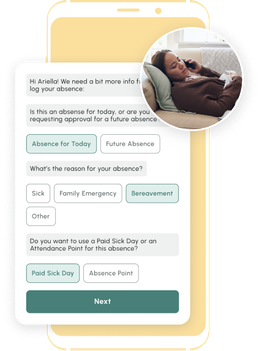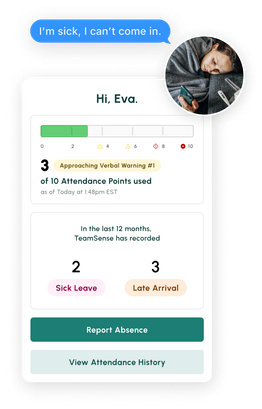Fix the root cause of No-Call No-Show with help from TeamSense
Table of Contents
- What is Employee Turnover?
- What causes employee turnover?
- How To Calculate Employee Turnover Rate
- What’s a Good Employee Turnover Rate?
- Why is Reducing Employee Turnover Important?
- How Has The Great Resignation Impacted Employee Turnover and Retention?
- How to Reduce Turnover in the Workplace and Improve Employee Retention
- 1. Embrace flexible schedules.
- 2. Enhance employee engagement and communication.
- 3. Offer training and career development opportunities.
- 4. Hire the right people.
- 5. Onboard with intentionality.
- 6. Stay competitive with your salary and benefits.
- 7. Improve your company culture.
- 8. Have recurring one-on-one meetings with your team members.
- 9. Keep an eye out for toxic team members.
- 10. Celebrate and recognize employees.
- How Absenteeism Impacts Employee Turnover
- Questions to Ask Your Existing Employees to Improve Retention
- Reduce Employee Turnover with Employee Engagement
Has “The Great Resignation” done a number at your company? These days, it seems like no company is a stranger to team member turnover. Between the draw of more flexible schedules, better benefits, and the influence of “quitfluencers” (Google it, it’s a thing)— getting your team to stay put is a difficult feat in 2022.
But even though employee retention can feel like an uphill battle, there are still plenty of ways to reduce employee turnover. We’ve got you covered with 10 essential tips to keep your team around and help them thrive.
What is Employee Turnover?
When we talk about employee turnover, that’s just a fancy way of talking about the number of employees who leave your organization. Employee turnover happens and is a regular flow of a company—team members leave the area or move on to different career paths, and some turnover is to be expected.
That said, since 2010, employee turnover has increased every year (with the only exception being 2020).1
What causes employee turnover?
Plenty of factors can cause employee turnover, from personal reasons to a general falling out with the company. And even though the deciding factor for an employee to call it quits will vary from team member to team member, there are usually some pretty common themes. Here are some of the top reasons employees leave.
Common reasons for employee turnover:
Health concerns
Found a job that paid more money
Moved to another city
Treated unfairly
Limited growth opportunities
Found a job closer to home
Burnout and stress
Little or no recognition of employees
Little or no feedback for employees
Overworked
Wanted a flexible schedule
Not on board with the company mission
How To Calculate Employee Turnover Rate
Employee turnover rate looks at the number of employees who leave an organization during a specific period of time. Many companies look back at the turnover rate for the previous year, but you can look by quarter or month as well.
So, let's say you want to focus on how many employees quit your company in the last month. To get your turnover rate during that time, you also need to know how many employees you had working on average. Then you'll divide the sum total number of who leave during the month by the number of employees who worked during that time. Multiply the number by 100, and you'll get your turnover rate.
Total number of employees who quit
_________________________ x 100 = X%
Total number of working employees
Let's say that in January, you lost several employees—15 to be exact. But you still had 100 employees remaining on staff. You'd calculate your turnover rate like this:
15 ÷ 100 = .15
or 15% employee turnover rate
Save 120+ Hours A Year Like Hello Fresh With TeamSense
See how TeamSense saved HelloFresh 3-4 hours per day managing attendance through text. Read the case study here and book your demo today!
What’s a Good Employee Turnover Rate?
A good rule of thumb is to shoot for an employee turnover rate of 10% or less, that way, you're retaining 90% of your workforce at any given point in time.
A standard employee turnover rate will also depend on your company's size. Because they are so large, some companies don't bat an eyelash at a 15% turnover rate. Still, 15% would severely impact the business of a smaller company.
Why is Reducing Employee Turnover Important?
Employee turnover can wreak some serious havoc at your company—everything from overhead operating costs to daily morale. That’s why the sooner you pay attention to employee turnover trends, the better. Here are just a few of the lasting effects of employee turnover:
Less productivity
Loss of team morale
Less efficiency
Cost of finding new employees
Strain on HR departments
Hiring the wrong people to fill the job ASAP
Loss of employee engagement
Onboarding costs
Recruitment costs
Training costs
Burnout of employees covering extra workload
More errors
Loss of skilled knowledge
Company culture impact
How Has The Great Resignation Impacted Employee Turnover and Retention?
By now, you’ve probably heard all about the employee mass exodus
(dubbed The Great Resignation) that began in 2021, shortly after the dust settled from the disruption of the global pandemic in 2020. In the month of November 2021 alone, 4.5 million employees quit their jobs—a 20-year record high.2
Of course, a record number of employees leaving their jobs created one heck of an employee turnover issue for HR teams across the country. But even though The Great Resignation left a trail of open job vacancies behind, as time has gone on, HR professionals are less interested in immediately backfilling those seats. Instead, they’ve shifted focus from talent acquisition to employee retention. Talent acquisition has fallen from HR’s second-highest priority to its eighth.3
In other words, they’re figuring out how to keep the people you already have instead of trying to get new folks in the door. And since it can cost one-half to two times an employee's annual salary to find their replacement, it makes sense to retain as many people as you can.4
How to Reduce Turnover in the Workplace and Improve Employee Retention
Reducing turnover and improving employee retention rates can feel like a never-ending battle. Just when your retention rate starts to tick up, here comes another batch of employees putting in their two-weeks notice. And the cycle continues—again.
The struggle is real, but it doesn’t have to defeat you. Here are 10 ways to reduce turnover and boost employee retention at your company.
1. Embrace flexible schedules.
With people working multiple jobs or balancing family obligations with work schedules, you might want to consider what a flex schedule would look like at your company. Of course, plenty of jobs can’t be done remotely, but flexibility isn’t just about working from home.
Think about the flexibility you can offer regarding shift schedules, locations, and making up time. Maybe that means you have a grace policy when it comes to clock-ins and let employees stay longer to make up the time. Maybe you offer multiple shift schedules for your team to choose from. Take a step back to reflect on what flexibility might mean to your employees and embrace a time off process that benefits both parties.
According to the Harvard Business Review, employees who don’t have flexibility at work are twice as likely to say they are dissatisfied at work, and half of employees said they would leave their current company if they were offered a more flexible alternative at another company.5
2. Enhance employee engagement and communication.
Having an open forum for your team to share their feedback is essential to the health and growth of a company. That’s why employee engagement and pulse surveys should be a must at your company.
And when you get those engagement surveys back from your team, be sure you take their insights into account when you make decisions and move the company forward. Too many times, companies think they’re done once they send out the engagement surveys and get at least 75% participation. But that’s just not the case. Be sure you take a good, hard look at the data you get back and then use it to make for a better employee experience for your team.

Boosting Efficiency: A 3PL Company Slashes Absenteeism by 39% with TeamSense
TeamSense changed the way this 3PL handled absenteeism, resulting in significant improvement in absenteeism rates, and can help your company too!
3. Offer training and career development opportunities.
When a team member feels like they’ve hit the ceiling when it comes to career growth at your company, you can bet they’ll be looking for one thing next—the door.
For 10 consecutive years, lack of career development and training opportunities was cited as the number one reason employees leave.6 Long story short? If you don’t invest in your team’s career growth, they’ll go somewhere that will.
A career development plan for your team members is essential to reduce employee turnover. And the investment will definitely pay off in the end. Companies with robust training and career development platforms can reduce employee turnover by 30-50 percent.7
4. Hire the right people.
Nip turnover in the bud before it ever happens by hiring the right fit for the job. If you select the right person when it comes to company culture, team fit, and skill set, that’s half of the battle.
When interviewing, be sure to convey the job role duties as clearly as possible. If you paint a false picture of the responsibilities or over-promise, the odds are higher that the employee won't be satisfied when they are actually doing the role day-to-day.
Consider bringing in a seasoned team member to be part of the interview as well. Team members in the trenches of the job daily can be a great resource. They can help figure out if the job candidate will fit the team's needs and if they understand the role entirely.
Sorry, there’s no crystal ball to gaze into to know if the candidate you’re thinking about hiring will hang around for 15 years or if they’ll bail on week three. But there are a few things to look out for while you’re vetting them:
Does their skill set fit the job role?
Are they a culture fit with the company?
Do they share excitement for the company’s mission?
Are they eager to meet the team?
Do they have a positive/can-do attitude?
Do they seem enjoyable to work with?
5. Onboard with intentionality.
So you found the right new hire to join your team—great! Now, make sure you onboard them in the best possible way. For some companies, onboarding is a huge deal. There are catered lunches, free company swag, and mixers to meet your new team. And at other companies, you sign a paper, maybe get a welcome letter, and then it’s off to the races.
If you think onboarding doesn’t really matter, think again. One in three new hires will leave a new company in their first 90 days on the job.8 Which means every touch point and impression of your company matters—especially onboarding.
Onboarding should set up your new hires for success, make them feel part of the team, and get them fired up about the company. You only get one chance to make a first impression, so make it count.
6. Stay competitive with your salary and benefits.
Leaving a job for a better opportunity—including higher pay—has historically been at the top of the list of why people quit their jobs. And that’s no different today. According to LinkedIn, competition and benefits still rank as the top priority for talent.9 And get this, companies highly rated in their salary and benefits offerings see a 56 percent lower turnover rate than companies not highly rated.10
It’s no surprise that paying your team well and continuing to provide raises over time can reduce employee turnover—but in the middle of 40-year high inflation, it’s even more essential to remain competitive.11
The only problem? Companies are being hit hard with inflation rates too, making it harder to give out the same pay increases and bonuses that they did in previous years. Consider ways to cut back on unnecessary expenses or put new roles on pause so that you can still compensate your current team fairly. Making an effort to retain your employees is worth the investment.
7. Improve your company culture.
Having a well-defined company culture doesn’t just happen. A solid company culture takes time to cultivate and intentionality to pull off. And you might be surprised at what actually goes into having an impact on your culture too. Culture isn’t just about dishing out free pizza in the break room and playing Secret Santa. There’s nothing wrong with those things, but they won’t be what your company is known for.
Company culture is about how your employees feel about your workplace and how they view their job. What's the overall impression they have when they think about the company? How do they feel about spending their day there? Is it miserable from the punch-in to punch-out, or do they feel valued?
Nearly 53% of people dread going to work.12 Do you think those companies have a good company culture? Probably not.
Overall, 67% of U.S. workers say their company culture is good or very good.13 But what about those who rate their workplace culture as poor? Well, not surprisingly, 90% of those employees have thought about quitting their job.14 Yikes. Don’t let that be you. Build a culture your employees can be proud of.

No one wants to talk to their boss or a 1-800 stranger to call off. Text changes everything - Reducing No Call No Shows.
8. Have recurring one-on-one meetings with your team members.
To put it bluntly, if you're not meeting with your team members to hear what’s on their minds, you’re not doing it right. You need a touch point with every individual on your team to give them a chance to openly communicate with you what’s on their mind. And one-on-one meetings are the best place to facilitate that.
The occurrence of these meetings is up to you—monthly or bi-weekly, or even weekly, are all possibilities. You might find that meeting every week is essential for a season, and then you can adjust to bi-weekly after that. Whatever you do, just make sure you put time on your calendars to talk.
9. Keep an eye out for toxic team members.
You’ve heard the phrase, “a rotten apple spoils the whole bunch,” right? Well, the same goes for having a toxic team member around. While the rest of the team is working together to overcome obstacles and function as one unit, the toxic team member is spewing their negativity on everyone else.
A disgruntled employee can make working conditions a nightmare. Remember, it’s much better to deal with the one toxic employee to nip it in the bud instead of letting that poison flow into the rest of the team.
10. Celebrate and recognize employees.
Being invisible at work (even though you’re excelling) is no fun. Nobody wants to go unrecognized for a job well done. And nothing can make you want to hightail it out of a company like continually being taken for granted.
So speak up! If you see an employee doing a good job—tell them. Or better yet, tell them in front of others so that the team can know the value they bring. You don’t have to wheel in a cake and shoot off confetti cannons (although you totally can if that's your thing). The truth is, It doesn’t take much effort to be genuine and let someone know that you see them.
How Absenteeism Impacts Employee Turnover
It’s not surprising that absenteeism can make employees care less about their job and their job performance. Team members who are generally apathetic about being at work are more likely to not be invested in your company—and more likely to leave.
Employee turnover is one of the most important HR metrics, and excessive absenteeism strongly predicts future employee turnover problems. If you have team members who are constantly missing work or showing up late, don’t be surprised if they’re next on the list of employees leaving your company.
Questions to Ask Your Existing Employees to Improve Retention
Thanks to “The Great Recession,” many companies are having something called “stay interviews” with their current team. What’s a stay interview anyway? Well, it’s just a chance for the company to ask employee questions and get an idea of what would improve retention rates—aka, what would make these team members stay with the company?
Whether you’re planning on doing stay interviews at your company or just want to have a few questions up your sleeve to ask in your next one-on-one meeting, here are a few questions to ask your existing employees to improve retention:
Do they feel valued and supported?
Do they feel like their needs are being met?
Do they have good relationships with their supervisor and colleagues?
Do they have adequate advancement opportunities?
Reduce Employee Turnover with Employee Engagement
To reduce employee turnover and improve retention rates, you need to have a better picture of what contributes to your organization's turnover problem. The best way to get an idea of what’s going on? Get insight from your employees. Find out what you can do to create an environment where people actually want to come to work.
There’s no denying spending time connecting and communicating with your team is valuable. In a recent study covering 2.7 million employees, Gallup found that companies in the top quartile of employee engagement have reduced absenteeism by 81%.15 And we know that fewer absent employees can be a good indicator of retention rates.
So how do you engage your employees? Get feedback and ideas for improvement through employee engagement and pulse surveys. Sending out engagement surveys is a valuable tool to help improve your company culture, lower absenteeism, and reduce employee turnover.

Is your call-in process terrible? Text reduces no-shows and absenteeism by up to 40%.
Don't believe us? Check out this case study to see how this 3PL benefited.
About the Author

Sheila Stafford, CEO of TeamSense & AI in HR Innovator
As CEO of TeamSense, Sheila Stafford is at the forefront of transforming HR for frontline teams through AI-driven solutions. With a commitment to enhancing employee relations and simplifying workforce management, Sheila leads TeamSense in pioneering advancements that empower both frontline employees and HR teams. Her visionary approach combines cutting-edge technology with a thoughtful focus on enhancing human connection; Sheila strategically implements AI where it adds the most value while recognizing the critical role of personal interaction and ensuring that human engagement remains central when it matters most. Under her leadership, TeamSense is redefining how companies support and engage their frontline teams for a more connected, efficient workplace.





